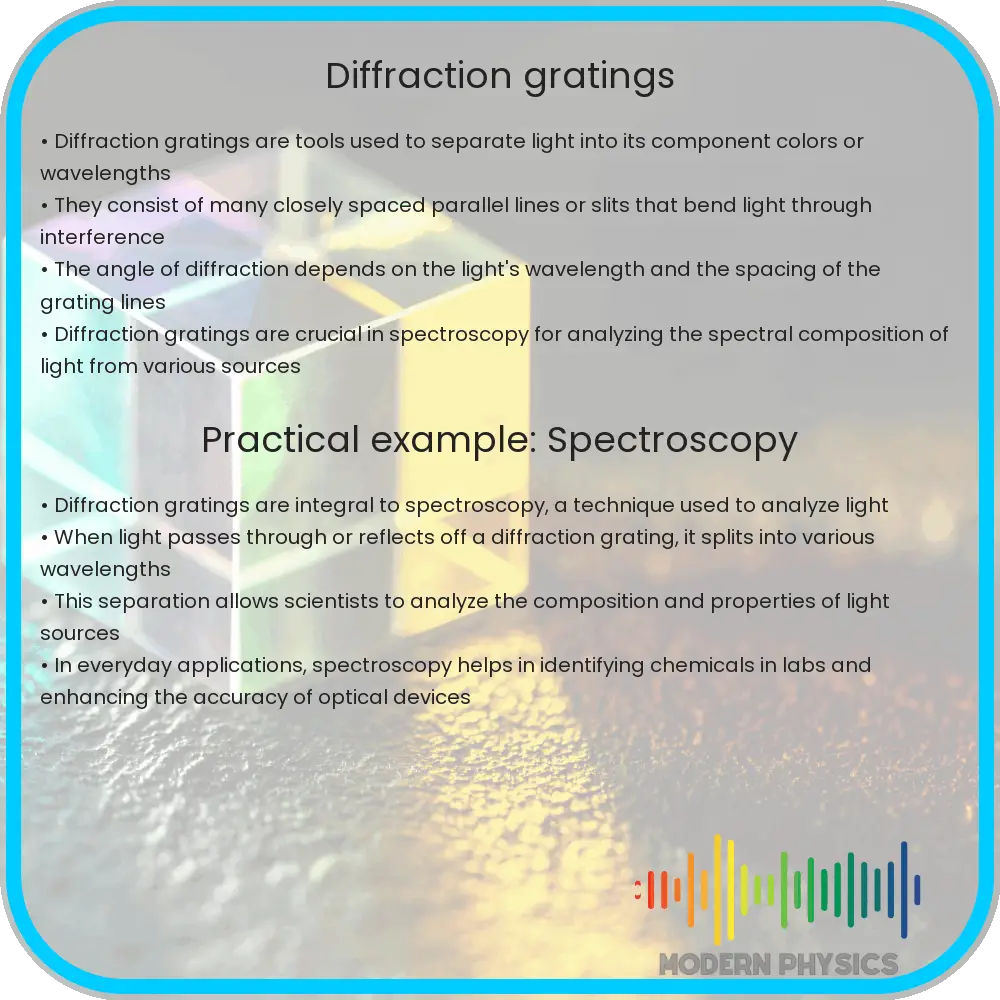Explore the types, applications, and spectra of diffraction gratings, crucial for spectroscopy, telecommunications, and laser technology.

Understanding Diffraction Gratings
Diffraction gratings are optical components used to separate light into its component wavelengths, functioning through the interference of light waves. They are essential in various scientific applications, from spectroscopy to laser systems. This article explores the types, applications, and the spectra produced by diffraction gratings.
Types of Diffraction Gratings
There are primarily two types of diffraction gratings: transmission and reflection gratings. Transmission gratings allow light to pass through them, while reflection gratings reflect the incident light. Each type has its subcategories, including ruled gratings, where grooves are physically etched onto a reflective surface, and holographic gratings, created by recording interference patterns of laser light.
Applications of Diffraction Gratings
Diffraction gratings are pivotal in numerous applications across various fields. In spectroscopy, they are used to analyze the spectral composition of light, identifying chemical substances through their spectral lines. In telecommunications, diffraction gratings help to separate different wavelengths of light, enhancing the capacity of fiber-optic cables. Additionally, they play a crucial role in laser technology, serving as tuning elements for laser wavelengths.
Spectra Produced by Diffraction Gratings
The spectra produced by diffraction gratings are characterized by their high resolution and precision. The diffraction process separates incoming light into its component colors, resulting in a spectrum. The angular dispersion of a grating, which describes how the separation of wavelengths varies with angle, is a critical factor in determining the resolution of the spectral lines. The equation governing the diffraction angle \(\theta\) is given by \(d\sin\theta = m\lambda\), where \(d\) is the grating spacing, \(m\) is the order of diffraction, and \(\lambda\) is the wavelength of light.
Understanding the principles and applications of diffraction gratings opens up a myriad of possibilities in scientific research and industrial applications. From analyzing the chemical composition of stars to improving the performance of optical systems, diffraction gratings play a pivotal role in advancing our technological capabilities.
Enhancing Spectral Analysis with Diffraction Gratings
The precision of spectral analysis significantly benefits from the utilization of diffraction gratings. By dispersing light into its constituent wavelengths, these optical components allow for the detailed examination of spectral features. This capability is crucial in fields such as environmental monitoring, where the spectral analysis of pollutants can help in assessing air or water quality, and in astronomy, where they aid in determining the chemical composition and physical properties of celestial objects.
Advancements in Diffraction Grating Technology
Recent advancements in diffraction grating technology have led to the development of more efficient and precise gratings. Holographic gratings, for example, offer advantages over traditional ruled gratings by reducing stray light and improving spectral resolution. Innovations in fabrication techniques have also made it possible to produce gratings with complex groove patterns, tailored for specific applications, enhancing their efficiency and versatility.
Challenges and Future Directions
Despite their widespread use, diffraction gratings face challenges, particularly in terms of efficiency and fabrication costs. The precision required in grating production can make them expensive to manufacture, limiting their accessibility for some applications. However, ongoing research focuses on developing cost-effective fabrication methods and materials that can increase the efficiency of diffraction gratings, promising broader applications and improved performance in the future.
Conclusion
Diffraction gratings are indispensable tools in the exploration of light and its properties. Their ability to disperse light into its spectral components has revolutionized various scientific fields, from spectroscopy to laser technology. As advancements continue to be made in the design and fabrication of diffraction gratings, their applications are set to expand further, offering new possibilities in scientific research and industrial applications. The future of diffraction gratings holds the promise of even greater precision and efficiency, continuing to unlock the mysteries of light and its interaction with matter.
